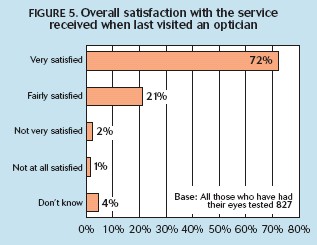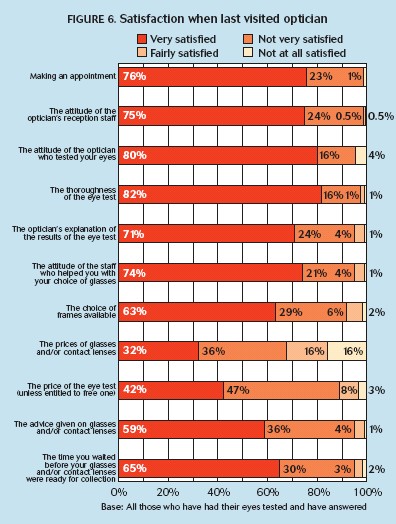In the first of three articles on consumer habits and attitudes to eye care, Alison Ewbank looks at what motivates people to visit an optical practice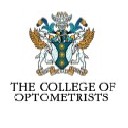
It's easy to assume that we know how the public views our profession. Talking to patients provides every opportunity to hear their opinions. But are these representative of all consumers? How often are we surprised by the lack of knowledge about what we do? And why does coverage of eye care in the lay media often seem simplistic or ill informed?
Many surveys have attempted to gauge consumer attitudes to optical services, but opinions and behaviour in relation to eye care and eyewear remain poorly understood compared with other health care and retail markets.
Little is known about what motivates consumers to visit an optical practice, to have an eye examination or to buy spectacles or contact lenses. Consumer perceptions of the scope of the profession's work are also unclear. Attitudes and behaviour in relation to having eye examinations and buying glasses may have changed as the market has become more consumer orientated and new types of outlet and supply route emerge.
OPTICIAN has therefore joined forces with the College of Optometrists to conduct a major survey of consumer behaviour, motivation and attitudes to eye care and eyewear among those who have visited an optometrist, and those who never have. The survey results may be used by the profession to formulate its future strategies and monitor their success, and by practitioners to inform their marketing decisions.
From March 17-22, NOP carried out 921 face-to-face interviews with consumers aged 15+ years, at random locations around Britain. The sample was designed to be representative of all adults in Britain and weighted to bring it into line with national population profiles.
At the start of each interview, it was explained that, for the purposes of the survey, 'optician' meant the person who examined the eyes and tested sight for glasses and contact lenses. Consumer terminology such as 'eye test' was used throughout the interviews to facilitate understanding.
WHO ATTENDS FOR EYE TESTS?
Almost nine out of 10 of adults in Britain (88 per cent) have had their eyes tested by an optician, but nearly one in eight (12 per cent) have never had an eye test.Women are more likely to have had their eyes tested than men (92 per cent vs 84 per cent). Attendance increases from 79 per cent among the 15-24 age group to almost all (99 per cent) among those aged 65+. Social classification ABs are more likely to have had an eye test than C2s (92 per cent vs 84 per cent) and there are variations between geographical regions. Attendance is highest in the East Midlands and lowest in the north of England (an area excluding Yorkshire, Humberside and the north west).
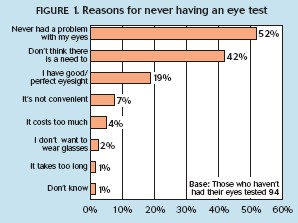
Among those who have never had their eyes tested, the most frequent reason is 'I've never had a problem with my eyes', cited by just over half of our sample (Figure 1). 'I don't think there's a need' and 'I have good/perfect eyesight' are the next most common reasons. Only 4 per cent cite cost as an issue. A surprising finding is that three-quarters of non-attenders in the early presbyope age group (44-54 years) say they have never had a problem with their eyes.
WHY DO THEY ATTEND?
The survey also explored factors that might prompt a visit to the optician among all consumers and revealed that behaviour tends to be reactive rather than proactive. Changes in their eyesight is the main motivating factor for visiting an optician, cited by two out of three adults (Figure 2). Problems with the health of the eyes and symptoms such as tired eyes or headaches would also prompt a visit. And there is strong evidence of the GP's influential role in recommending an eye test; almost half of all consumers would be prompted to attend if their doctor recommended it.Discounted prices would seem to have less influence on attendance. According to our survey, special offers on glasses and on the eye test are much less likely to result in a visit to the optician than other factors. Advertising and editorial prompts, whether generic or for a particular optician, are also low on the list.
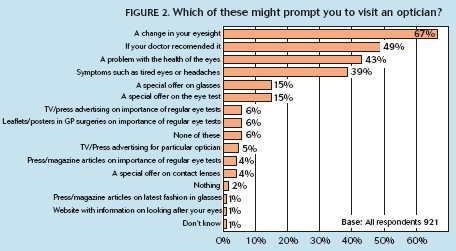
Women are more likely to be influenced by special offers on glasses or on eye tests than men; 18 per cent of women said that special offers would prompt a visit compared to 12 per cent of men. Discounted eye tests were more attractive to 15 to 24-year-olds than to any other age group, although a proportion of these would be entitled to a free test. Special offers on glasses tended to be more attractive to those aged 44-55 and over.
When asked to state spontaneously the reason why they usually went to the optician, more than eight out of 10 say 'to get my sight tested' but, encouragingly, one in four say they go to have the health of their eyes checked. At 22 per cent, the proportion who say they go 'to get new glasses' is relatively low.
HOW OFTEN DO THEY VISIT?
Our survey asked all those interviewed how often they should have their eyes tested (Figure 3). Almost all think the appropriate interval is within two years; the highest proportion say every year and one in three say every two years. A surprising number of consumers think they should have an eye test every six months.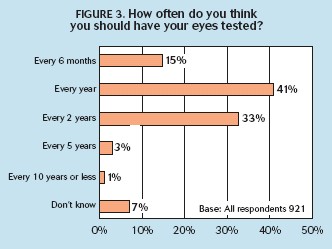
When those who have attended for an eye test are asked how frequently they normally go, the most common interval is two years rather than a year (Figure 4). Among this group nearly one in four either leave five years or more between visits or do not know how often they have their eyes tested. Women are more likely to attend regularly than men and consumers aged 65+ are as likely to attend every year as every two years.
In the final question relating to frequency of visits, those who had had their eyes tested by an optician were asked how long ago they had their last test. Although all practitioners will be aware that patients tend to underestimate this time interval, more than half (58 per cent) claim they have had an eye test within the past 12 months. A small but important minority (8 per cent) say their last test was more than five years ago.
ARE THEY SATISFIED?
There was good news for the profession when overall satisfaction with the service they provide was investigated. Almost all were satisfied with the service at their last visit and more than seven out of 10 were 'very satisfied' (Figure 5). This is a very similar result to an optician survey in 1997, also conducted by NOP, which found that 72 per cent of consumers wearing vision correction were 'very satisfied' with the eye test they received and another 24 per cent were 'fairly satisfied'.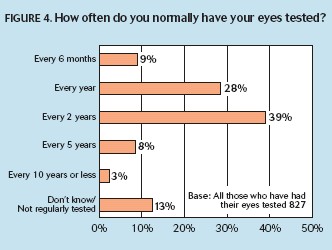
In the present survey, a high proportion also say their optician offered overall good value for money; seven out of 10 described their last visit as 'very good' or 'fairly good' in this respect, although 14 per cent described value for money as 'not very good' or 'not at all good'.
Similar trends were seen in levels of satisfaction with various elements of their last visit (Figure 6). The attitudes of the practice staff and aspects of the eye examination and were all rated highly; at least 95 per cent were 'very satisfied' or 'fairly satisfied' with these elements of the service. But consumers were generally less satisfied with prices and, interestingly, the choice of frames available.
So what can practitioners take home from these findings? The profession should certainly feel encouraged by the level of attendance for eye tests, the frequency of visits, and consumer satisfaction with the service and value provided. But changes in eyesight rather than the need for preventative health checks remain the key market driver and many consumers have never had their eyes tested because they simply do not see the need. Cost would seem to be less of an issue than some might expect and a doctor's recommendation is more effective than any form of health promotion or advertising.
